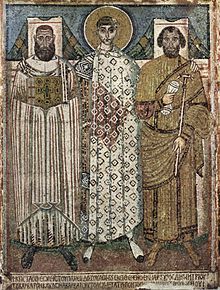Mosaics of the Demetrius Church in Thessaloniki
At the end of the 6th century or the beginning of the 7th century, unknown artists created mosaics in the church of Hagios Demetrios in Thessaloniki , Greece.
The mosaics in the church dedicated to Saint Demetrios were made after 620, after a fire in the church. They are among the most important examples of Byzantine art .
The mosaics of the saint
After relics of Saint Demetrios before the onslaught of the Huns were brought to Thessaloniki from Sirmium in present-day Serbia around 440 , as assumed, the city of Thessaloniki developed into a center of veneration for the saint in the 6th century. Demetrios became one of the most important saints of the Eastern Church , but later, for example in the 13th century, he also became known in the Western Church. Two mosaics depict the saints alive and close. They show the saints and the clothes of Byzantine court officials so precisely that they are still an interesting source of the function of color and clothes in Byzantine court ceremonies.
Even if the depictions of the saint already follow the strict Byzantine style that was later customary with a formulaic language, they are created in an almost painterly style. Other mosaics in the church, such as the medallion pictures from the same construction phase, have a more linear style in comparison, for example in the drapery of the clothes, and were therefore certainly designed and set by other artists.
Art-historical interpretation of the mosaics
The Church of Demetrios was converted into a mosque after the conquest of Greece by the Ottoman Empire and the mosaics were hidden under plaster. After their rediscovery, they were restored between 1917 and 1949, and then renovated and examined again since 1998. Even if the use of emergency names is not common in the Byzantine art history , there is agreement that the pictures of Saint Demetrios in his church in Thessaloniki are one of the masterpieces of Byzantine art and of early Christianity. They are an important work of art that can contribute to the understanding of the development of the understanding of faith and the role of the veneration of saints not only in the Eastern Church. The distinction between artists of the mosaics can indicate how artists, under the leadership of the Byzantine court and its clergy, individually endeavored to implement and represent new religious ideas on the walls of the church and how they wanted to achieve it, the church and the community bring their saints close to life.
Viewing the mosaics can contribute to an understanding of the prehistory of the so-called Byzantine Pictorial Controversy, the theological debate that arose about a hundred years after its emergence in the Eastern Church and the Byzantine imperial family about the correct use and regulation of art and artists in the portrayals of people in churches. The mosaics are also an important picture in the history of the development of the late Roman world, in the transformation of this world from the year 400 to the year 900 and the origin of a Europe that also adopted elements of Byzantine art such as the depictions of saints by Demetrius early on in the west and processed, albeit from the perspective of a Western church policy.
Individual evidence
- ↑ The emergency name Meister der Demetrius-Kirche in Saloniki is an invention of the company DIRECTMEDIA Publishing GmbH (Hrsg.): The Yorck Project: 10.000 masterpieces of painting. DVD-ROM, 2002. ISBN 3936122202 , it does not exist in scientific literature.
- ↑ see e.g. Ian Wood: The transmission of ideas . In: L. Webster, M. Brown (Eds.): The Transformation of the Roman World AD 400-900. London 1997.
literature
- Robin S. Cormack: The Mosaic Decoration of S. Demetrios, Thessaloniki: A Re-Examination in the Light of the Drawings of WS George . In: Annual of the British School at Athens 64 (1969), pp. 17-52
- Thanases Papazotos: Το ψηφιδωτό των κτητόρων του Αγίου Δημητρίου Θεσσαλονίκης . Macedonica Parartima (Μακεδονικά Παράρτημα) 5. Thessaloniki 1983.
- Charalambos Bakirtzis: The Basilica of St. Demetrius . Thessaloniki 1988
- Chrysanthi Mavropoulou-Tsioumi: Byzantine Thessaloniki . Thessaloniki 1992
- Eutychia Kourkoutidou-Nikolaidou, Anastasia Tourta: Walks through Byzantine Thessaloniki . Athens 1997
- Iannis O. Kanonidis, Pelli Mastora: Preservation of the mosaics at the Rotonda of Agios Georgios, the basilica of Agios Demetrios and the church of Agia Sofia, Thessaloniki, 1997-1999 . In: P. Blanc (Ed.): Proceedings of the VIIth Conference of the International Committee for the Conservation of Mosaics (ICCM), "Mosaics: Conserve to display?" Arles - Saint-Romain-en-Gal, April 22-28 November 1999. Arles 2003, pp. 403-413
- Benjamin Fourlas: Κτίστας θεωρεῖς. Who is the civil dignitary on the donor mosaic in the Demetrios Church in Thessaloniki? . In: Byzantina Symmeikta 20, 2010, pp. 195–244 full text

